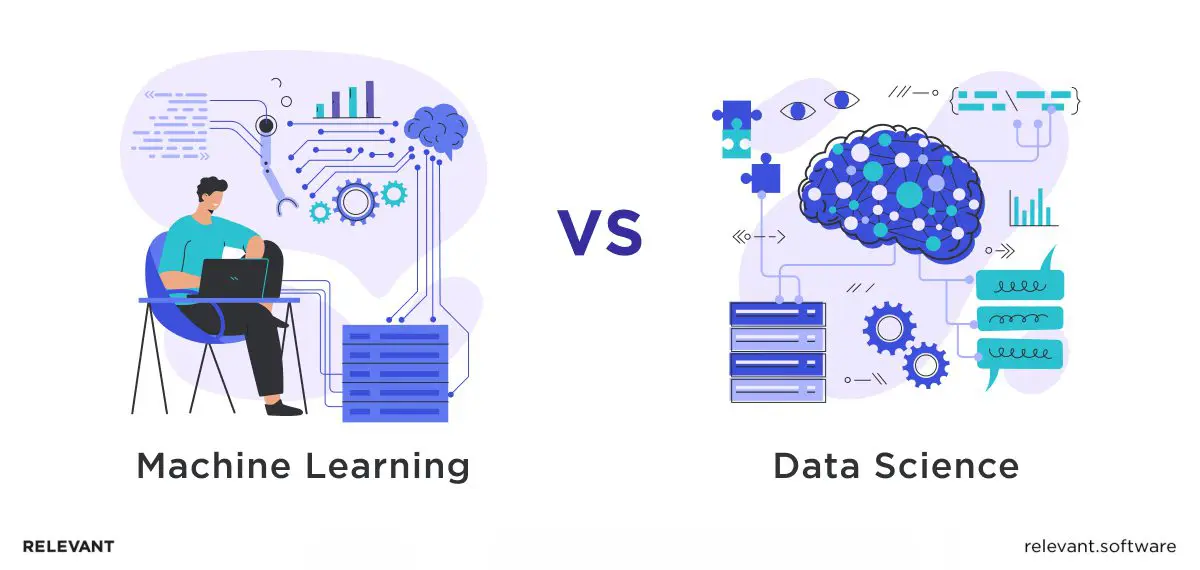Machine Learning vs Data Science: Expound on the Differences and Synergies

Over recent years, the surge in interest and application of artificial intelligence, in particular, machine learning vs data science, has reached a point where most businesses are now embarking on their journey toward digital transformation, aiming for the fully integrated and automated environment known as Industry 4.0.
Faced with high uncertainty and stagnant growth, business leaders are now compelled to extract maximum value from every asset. This motivation has prompted them to probe new growth avenues via AI development services – particularly machine learning (ML) and data science (DS). However, as often happens with digital advancements, the introduction of these technologies frequently brings a degree of confusion.
While machine learning vs data science frequently overlap, they each have unique traits and applications that can make or break your strategic efforts. To truly capitalize on these technologies, it’s important to understand their individual and collective roles clearly. We will explain how these AI subsets differ and complement each other to give you a real strategic edge.
What is Machine Learning: Fundamentals and More
Machine learning represents a specified subset of artificial intelligence that enables computers to learn from and make data-based decisions. Unlike traditional programming, where humans explicitly define the rules, ML uses algorithms to understand patterns and make predictions from data without being explicitly programmed to perform specific tasks.
These are not generic predictions but highly accurate, data-driven ones that evolve and improve as the system ingests more data. For instance, in financial services, ML can anticipate fraudulent transactions with high accuracy, which allows companies to address potential threats before they manifest preemptively.
Key elements in machine learning include:
- Algorithms in ML are specific sets of rules or instructions programmed into a machine. Essentially, algorithms are the foundation that dictates how a machine processes information and identifies patterns that are not immediately obvious.
- A model is the output or result generated after an algorithm has been trained with data. It represents the knowledge or patterns the machine learned in the training phase. Think of a model as a distilled essence of the data, which embodies the insights and patterns discovered by the algorithm.
- Training is the process of feeding data to an ML algorithm to enable it to learn. The algorithm adjusts and refines its approach based on the data inputs and the feedback it receives, which enhances its ability to predict or categorize future data inputs accurately.
- Inference is the phase where the trained model applies the knowledge it has acquired to make predictions or decisions about new, unseen data.
Machine Learning Workflow
The ML workflow is broken down into several key stages, each vital for the successful outcome of a machine learning project. Let’s explore these stages to understand how each contributes to building a robust model:
- Data Preprocessing: This stage is crucial because the quality and format of the data directly affect the success of subsequent model training. Data preprocessing means fixing missing values, scaling data uniformly, and converting categorical variables to numerical formats. This approach ensures that the ML algorithms receive clean and structured data, which helps reduce model errors and enhance prediction accuracy.
- Model Training: Throughout this phase, ML algorithms process preprocessed data to learn from its features. This can be achieved through various techniques, such as supervised learning, where the model is trained on a labeled dataset, and unsupervised learning, which helps discover patterns in data without pre-existing labels. The selection of the algorithm, which can range from linear regression to complex neural networks, depends on the type of problem, the complexity of the data, and the desired outcome.
- Evaluation and Deployment: After preparation, models undergo a thorough evaluation to measure their predictive performance through metrics such as accuracy, precision, recall, and F1 score. Models that meet the performance criteria are then deployed into real-world applications, operating on new, unseen data to provide insights or automated decisions. This stage also involves regular checkups and updates of models to adapt to new data or changes in their application environment.
Applications of Machine Learning
The applications of ML are vast and varied, which demonstrates its ability to adapt and drive significant advancements in almost any field. We summarized them in the table:
| Industry | Machine Learning Application | Description |
| Healthcare | Disease Diagnosis Treatment Personalization | ML models check patient data and medical images to determine diseases more accurately. Algorithms tailor treatment plans based on individual patient data and disease patterns. |
| Finance | Fraud Detection Algorithmic Trading | ML algorithms monitor transaction patterns to quickly identify potential fraudulent activity. Systems use ML to predict stock market trends and execute trades automatically. |
| Retail | Customer SegmentationInventory Management | ML categorizes customers into clusters with similar behaviors for targeted marketing. Predictive models forecast demand to optimize stock levels, which reduces overstock and understock situations. |
| Automotive | Autonomous Cars Predictive Maintenance | ML powers self-driving cars, processing sensor data to navigate roads safely. Algorithms predict when vehicle components might fail, which allows timely maintenance. |
| Technology | Natural Language Processing (NLP) Image and Video Recognition | ML improves user interaction via voice recognition and chatbots. Advanced ML models recognize and interpret content in images and videos for various applications. |
The Roadblocks to Success in Machine Learning
Machine learning, while transformative, comes with its set of challenges that can complicate the development and deployment of effective models.
- Data Quality and Quantity: The principle “garbage in, garbage out” is especially relevant in ML. When trained on flawed or biased data, models are prone to produce unreliable outcomes. This emphasizes the critical need for high-quality, comprehensive datasets. Quality data must be accurate, representative, and free from biases to ensure that the models developed are both effective and fair. Large-scale datasets enhance the model’s ability to discern and generalize from patterns, which reduces the likelihood of anomalies that influence outcomes significantly.
- Model Complexity and Interpretability: As ML models become more sophisticated, their operations become less transparent, which makes it harder for users to understand the basis of their decisions. Stakeholders are naturally more inclined to trust and depend on ML applications if they can easily grasp the logic behind their decisions. This highlights the need to develop models that find a balance between complexity and interpretability.
- Overfitting and Underfitting: These affect the model’s ability to generalize to new data.
- Overfitting occurs when a model captures both the subtle nuances and noise in the training data to such an extent that it impairs the model’s effectiveness on new data. This issue often arises with complex models with too many parameters compared to the available observations.
- Conversely, underfitting happens when a model is too simplistic to accurately capture the fundamental patterns in the data. This typically results from overly simplistic models that fail to account for the data’s complexities. Both scenarios require meticulous adjustment of the model’s parameters and strategic selection of features throughout the preparation process to ensure the model performs well in real-world applications.
What is Data Science?
While ML zeroes in on prediction, data science can interpret those predictions and extract knowledge and insights from structured or unstructured data, often referred to as “big data.” In practice, data science involves the usage of scientific reasoning methods to address data-related questions, such as experimental design, causal inference, statistical methods, predictive modeling, and more (in various contexts). A key characteristic of DS is the consistent involvement of a human in the loop who interprets insights, views data representations, and applies results.
Key Components of Data Science
Typically, a data science workflow involves stages like:
- Data Collection and Processing: The first step in the data science workflow involves data collection from multiple sources, which could include databases, online transactions, and customer interactions. After being gathered, the data must be cleaned and processed. This stage is critical because it verifies the accuracy of the data and ensures it has the proper format for analysis. Techniques such as data transformation and data enrichment are often used to improve the quality and utility of the data.
- Exploratory Data Analysis (EDA): A crucial component of data science, EDA aims to outline the primary attributes of a dataset, often through visual graphs. It provides better insights into the data’s underlying structures, highlights potential anomalies, and identifies patterns or correlations between variables. This step is vital if you need to discover insights and decide the direction of further analysis.
- Predictive Modeling and Analytics: Predictive modeling employs statistical techniques and ML algorithms to forecast future events from historical data. This area of data science is essential for applications such as customer behavior prediction, risk assessment, and demand forecasting. Predictive analytics helps businesses anticipate changes and plan strategies effectively, which helps to leverage the predictive power to gain a competitive edge.
Data science integrates these components to foster innovation and efficiency, which fundamentally shapes strategic decision-making processes.
Applications of Data Science
Data science finds its application across a diverse range of fields, each benefiting from its ability to extract insights and make informed decisions from complex datasets. Here is a table with some key areas where data science plays a pivotal role:
| Industry | Application of Data Science | Description |
| Healthcare | Disease Prediction and Diagnosis | Uses patient data and predictive models to diagnose diseases early and accurately. |
| Finance | Fraud Detection | Analyzes transaction patterns to identify and prevent fraudulent activities. |
| Retail | Customer Segmentation and Personalization | Segments customers based on behavior and preferences to tailor marketing efforts. |
| Manufacturing | Quality Control and Predictive Maintenance | Monitors production lines to predict and prevent equipment failures and ensure product quality. |
| Transportation | Route Optimization | Analyzes traffic data to optimize delivery routes and reduce fuel consumption. |
| E-commerce | Recommendation Systems | Provides personalized product recommendations to users based on their browsing and purchase history. |
| Energy | Load Forecasting | Predicts energy demand to improve grid management and reduce operational costs. |
Machine Learning vs Data Science: A Comparative Overview
While data science vs machine learning are closely linked, they are not interchangeable. They serve different purposes within the analytics hierarchy. There is a simplified explanation for the distinctions among the three disciplines:
- Data science generates insights
- Machine learning generates predictions
- Artificial intelligence generates actions

Overlapping Areas
Machine learning technology doesn’t work in isolation but as a part of the data science workflow, where it acts like a lens that focuses the scattered rays of raw data into a coherent beam of insight. ML models, crafted by the hands of data scientists, serve not just to predict but to illuminate the path ahead based on the data they digest.
You can apply ML to tasks beyond the typical DS scope (despite relying on data fundamentally), and you can engage in DS without the usage of ML (particularly for simpler tasks), yet in practice, they are increasingly essential to each other nowadays.
Focus Areas
Machine learning essentially targets constructing models that forecast future outcomes based on historical data. This specialty applies data to predict scenarios like customer behavior, stock market trends, or potential health issues.
In contrast, data science takes a broader view and deals with predictive and descriptive analytics that explains what happens now and prescriptive analytics that suggests actions based on the data.

Skill Sets and Tools
Machine learning specialists typically rely on a deep knowledge of ML algorithms like neural networks, decision trees, or support vector machines. They frequently use programming languages such as Python and libraries like TensorFlow and scikit-learn, which are specifically designed to develop and train ML models.
On the other hand, data scientists have a broader toolkit that includes proficiency in data manipulation (through straightforward tools like SQL or pandas), data visualization (with advanced techniques like Tableau or Matplotlib), and foundational ML expertise. Regardless of the complexity of the processes, the objective remains to deepen understanding of the data.
End Goals
The ultimate goals of ML and DS also differ significantly. Machine learning is to build models that can predict future outcomes with minimal human intervention. These models are trained to make decisions based on data, and they continually learn and adapt to new data.
The end goal of data science is broader. It aims to extract insights from data that inform decision-making. This includes predictions but also involves comprehensive analysis that can help organizations strategically plan and execute based on a wide array of data-driven insights.
Here’s a detailed table that showcases the key differences between data science vs machine learning:
| Aspect | Machine Learning | Data Science |
| Definition | A branch of artificial intelligence that enables systems to learn from data, improve from experiences, and make predictions. | A multidisciplinary field that uses scientific methods, processes, algorithms, and systems to extract knowledge and insights from structured and unstructured data. |
| Primary Focus | Development of algorithms to make predictions or decisions based on data. | Holistic analysis of data to extract insights, inform decisions, and solve complex problems. |
| Key Techniques | Supervised learning, unsupervised learning, neural networks, deep learning. | Data mining, statistical analysis, predictive modeling, machine learning, data visualization. |
| Tools Commonly Used | TensorFlow, PyTorch, Scikit-learn, Keras. | Python, R, SQL, Tableau, SAS, Spark. |
| Outputs | Predictive models that can automate decision-making processes and forecast outcomes. | Insights, reports, and dashboards that guide business strategy and operational improvements. |
| Skill Sets | ML algorithms, deep learning, statistical modeling, computer science. | Statistical analysis, data visualization, data engineering, domain expertise. |
| Applications | Real-time recommendations (e.g., Netflix, Amazon), autonomous vehicles, speech recognition, and fraud detection. | Market analysis, customer segmentation, risk management, logistics optimization, and policy development. |
| End Goals | To create models that can perform specific tasks without being explicitly programmed for each task. | To understand data patterns, derive meaningful insights, and make informed decisions based on comprehensive data analysis. |
| Data Requirements | Requires large volumes of data for accurate predictions and model enhancement. | Uses both large and small data sets, structured and unstructured data, to derive insights. |
| Impact on Decision-Making | Typically automates decision-making and applies learned models to new data. | Enhances decision-making by providing deep insights and understanding patterns that are not immediately obvious. |
A Simple Scenario of Use
Let’s envision that your factory specializes in fabrication high-performance computer chips. Your machines adhere to precise manufacturing protocols daily, yet the output quality occasionally varies. To address these quality inconsistencies, you would employ three key technologies: data science vs machine learning vs AI.
Data Science
Imagine your company notices inconsistencies in the performance of your chips. Upon you receive feedback about these issues, you start to hypothesize the possible causes. Is it due to a variation in silicon wafer quality? Did a change in temperature settings affect the outcome? Could an interruption in the assembly line have caused the discrepancies? DS allows your team to analyze data and models to pinpoint which factors might have influenced the quality of the chips.
Machine Learning
From this analysis, your data scientist develops a supervised ML model that embodies the ideal chip manufacturing process. This model learns to recognize the variables that consistently produce high-quality chips and those that lead to defects. Through ML, your team discovers that fluctuations in temperature settings throughout the manufacturing process cause inconsistencies. The model then helps adjust the process in real-time to maintain optimal temperatures, regardless of external factors.
Artificial Intelligence
Soon after, when a similar issue arises with temperature fluctuations, the AI system, informed by previous ML findings, automatically adjusts the manufacturing settings. It compensates for the temperature variance by modifying other related parameters to ensure that the chips still meet quality standards. The production line self-corrects through AI, which will result in consistently high-quality computer chips.
As you can see, the real power emerges when businesses synergistically harness data science vs machine learning vs AI in their workflows. Machine learning’s predictive capabilities, embedded within a comprehensive data science analytics framework, enable more informed strategy formulation.
With AL, machine learning vs data science as your guides, you’re no longer just a market participant—you’ll confidently lead your business through the corporate world’s ever-shifting scenes.

Machine Learning vs Data Science: Final Words
At Relevant Software, we don’t oppose data science vs machine learning but use them in tandem to meet each client’s specific needs. Here’s how we adapt our expertise to fit your unique business requirements and objectives.
Bespoke ML Models
We focus on the creation of specialized ML models that are directly aligned with your business goals and operational needs. Each model is designed to integrate seamlessly with your existing systems and is equipped to learn and evolve with your continuous data inputs. This means they become more accurate and reliable as they adapt to your business environment.
Customized Data Science Insights
Our data science services are fully bespoke to deliver relevant and transformative insights for your business. We analyze your data through advanced statistical techniques to unearth trends and insights that inform critical decision-making. Our aim is to provide clear, actionable insights that can directly influence your business strategies and operations.
Integrated ML and DS Strategies
Through the unification of machine learning vs data science, we craft comprehensive strategies that enable your business to both predict future trends and understand the dynamics behind these predictions. This integrative approach provides a clear view of what might happen next, which arms you with the insights to make informed strategic decisions.
So contact us if you want to gain a service provider and a strategic partner committed to your long-term success.



